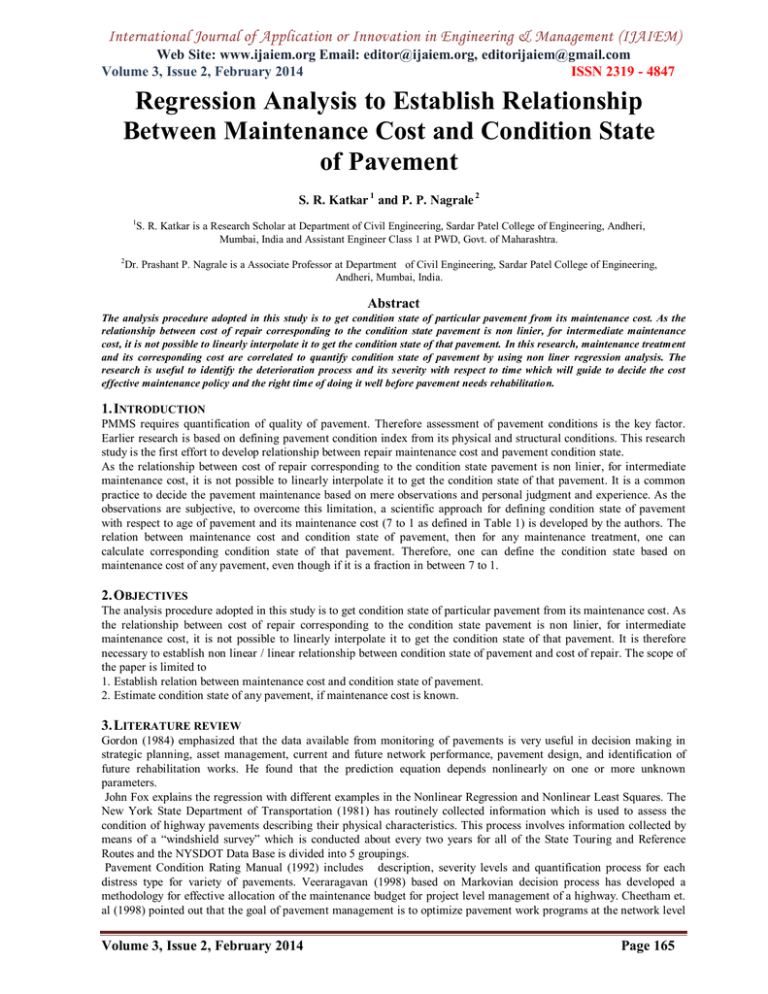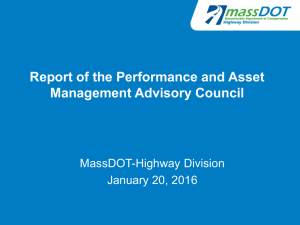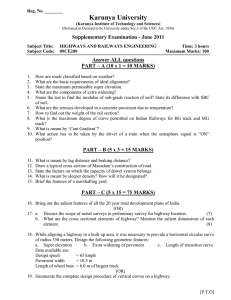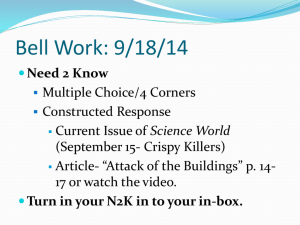International Journal of Application or Innovation in Engineering & Management... Web Site: www.ijaiem.org Email: , Volume 3, Issue 2, February 2014
advertisement

International Journal of Application or Innovation in Engineering & Management (IJAIEM) Web Site: www.ijaiem.org Email: editor@ijaiem.org, editorijaiem@gmail.com Volume 3, Issue 2, February 2014 ISSN 2319 - 4847 Regression Analysis to Establish Relationship Between Maintenance Cost and Condition State of Pavement S. R. Katkar 1 and P. P. Nagrale 2 1 S. R. Katkar is a Research Scholar at Department of Civil Engineering, Sardar Patel College of Engineering, Andheri, Mumbai, India and Assistant Engineer Class 1 at PWD, Govt. of Maharashtra. 2 Dr. Prashant P. Nagrale is a Associate Professor at Department of Civil Engineering, Sardar Patel College of Engineering, Andheri, Mumbai, India. Abstract The analysis procedure adopted in this study is to get condition state of particular pavement from its maintenance cost. As the relationship between cost of repair corresponding to the condition state pavement is non linier, for intermediate maintenance cost, it is not possible to linearly interpolate it to get the condition state of that pavement. In this research, maintenance treatment and its corresponding cost are correlated to quantify condition state of pavement by using non liner regression analysis. The research is useful to identify the deterioration process and its severity with respect to time which will guide to decide the cost effective maintenance policy and the right time of doing it well before pavement needs rehabilitation. 1. INTRODUCTION PMMS requires quantification of quality of pavement. Therefore assessment of pavement conditions is the key factor. Earlier research is based on defining pavement condition index from its physical and structural conditions. This research study is the first effort to develop relationship between repair maintenance cost and pavement condition state. As the relationship between cost of repair corresponding to the condition state pavement is non linier, for intermediate maintenance cost, it is not possible to linearly interpolate it to get the condition state of that pavement. It is a common practice to decide the pavement maintenance based on mere observations and personal judgment and experience. As the observations are subjective, to overcome this limitation, a scientific approach for defining condition state of pavement with respect to age of pavement and its maintenance cost (7 to 1 as defined in Table 1) is developed by the authors. The relation between maintenance cost and condition state of pavement, then for any maintenance treatment, one can calculate corresponding condition state of that pavement. Therefore, one can define the condition state based on maintenance cost of any pavement, even though if it is a fraction in between 7 to 1. 2. OBJECTIVES The analysis procedure adopted in this study is to get condition state of particular pavement from its maintenance cost. As the relationship between cost of repair corresponding to the condition state pavement is non linier, for intermediate maintenance cost, it is not possible to linearly interpolate it to get the condition state of that pavement. It is therefore necessary to establish non linear / linear relationship between condition state of pavement and cost of repair. The scope of the paper is limited to 1. Establish relation between maintenance cost and condition state of pavement. 2. Estimate condition state of any pavement, if maintenance cost is known. 3. LITERATURE REVIEW Gordon (1984) emphasized that the data available from monitoring of pavements is very useful in decision making in strategic planning, asset management, current and future network performance, pavement design, and identification of future rehabilitation works. He found that the prediction equation depends nonlinearly on one or more unknown parameters. John Fox explains the regression with different examples in the Nonlinear Regression and Nonlinear Least Squares. The New York State Department of Transportation (1981) has routinely collected information which is used to assess the condition of highway pavements describing their physical characteristics. This process involves information collected by means of a “windshield survey” which is conducted about every two years for all of the State Touring and Reference Routes and the NYSDOT Data Base is divided into 5 groupings. Pavement Condition Rating Manual (1992) includes description, severity levels and quantification process for each distress type for variety of pavements. Veeraragavan (1998) based on Markovian decision process has developed a methodology for effective allocation of the maintenance budget for project level management of a highway. Cheetham et. al (1998) pointed out that the goal of pavement management is to optimize pavement work programs at the network level Volume 3, Issue 2, February 2014 Page 165 International Journal of Application or Innovation in Engineering & Management (IJAIEM) Web Site: www.ijaiem.org Email: editor@ijaiem.org, editorijaiem@gmail.com Volume 3, Issue 2, February 2014 ISSN 2319 - 4847 and to optimize pavement rehabilitation designs at the project level. Within the pavement management process, performance predictions are very important in developing optimized multiyear work programs, as well as for evaluating the life cycle cost-effectiveness of project designs. The study conducted at Texas Department of Transportation by Bryan Stampley et. al (2009) summarized the use of pavement scores by various states, including the rating methods, score scales, and descriptions. Based on the pavement score, the committee described the guidelines to design pavement maintenance and rehabilitation actions; how the scores are computed; the distresses that are used for generating the scores; the sampling method; the survey frequency; and each state agency’s internal goal. Butt et. al (1994) used probabilistic technique to predict future condition state of pavement by using current pavement conditions. They found this technique superior to others such as straight line extrapolation and regression. Literature review and study observations have revealed that not only traffic loads but construction technique, quality of materials and control on quality standards adopted during construction of road are the important parameters causing the deterioration and condition state of pavement. There are various methods to identify the condition state but the procedures are too lengthy and time consuming. Indices like PCI etc. may give false indication in deciding the maintenance policy as pavements needing different maintenance treatment may have similar PCI. To accurately predict the future condition state and decide most appropriate PMMS, an attempt is made in this paper to establish the relationship between condition state of pavement and its corresponding maintenance cost which will be helpful in identifying the condition state of pavement based on maintenance treatment cost required to that pavement. 4. METHODOLOGY It is a common practice to decide the pavement maintenance based on mere observations and personal judgment and experience. As the observations are subjective, to overcome this limitation, a scientific approach for defining condition state of pavement with respect to age of pavement and its maintenance cost is developed by the authors. Typical construction procedure used by Public Works Department of Maharashtra state is considered. Average pavement life of bituminous rural road is observed as 14 years and hence the entire life span is divided into 7 equal periods i.e. regularly at 2 years. Maintenance cost for such several pavement stretches in single lane rural road network is calculated for each of 2 year span of observation. Average cost of each condition state is then identified from this data. Based on this observations condition state pavements are defined in to 7 categories – from 7 (new condition state) to 1 (poor condition needing immediate total rehabilitation). For rate analysis, District Schedule Rates of Public Work Department, Pune 2012-13 is referred. Table 1 shows the different condition state descriptions of the pavements and corresponding repair cost required for rehabilitation / renovation up to new condition state. Table 1: Different Condition State Descriptions of the pavements and corresponding repair cost required for rehabilitation / renovation up to new condition state. Condition state Description 7 New condition: Routine maintenance & Nominal Seal coat within DLP. Good condition: Pot hole filling by OGC with seal coat material. Generally good condition: Potential exists for minor maintenance (Nominal BBM pot hole filling & OGC with seal coat). Major maintenance required: 40 - 50% BBM & OGC with seal coat. Minor rehabilitation required: Pot hole filling by Normal size metal, BBM layer & OGC with seal coat. Marginal condition: Potential exists for major rehabilitation (Pot hole filling by Oversize metal layer, Normal size metal layer, BBM layer & OGC with seal coat). Poor condition: Rehabilitation required immediately. (Repairing by partially blanketing, Over size metal layer, Normal size metal layer, BBM layer & OGC with seal coat). 6 5 4 3 2 1 Repair cost corresponding to condition state in lakhs of Rs. for 3.75 m width road per Km 0.97 4.12 9.38 14.81 22.47 30.85 40.59 The relationship between condition state of pavement v/s corresponding maintenance cost is plotted as shown in figure 1 that helps to predict the nature of deterioration. The figure 1 shows maintenance cost against time explaining the process. Volume 3, Issue 2, February 2014 Page 166 International Journal of Application or Innovation in Engineering & Management (IJAIEM) Web Site: www.ijaiem.org Email: editor@ijaiem.org, editorijaiem@gmail.com Volume 3, Issue 2, February 2014 ISSN 2319 - 4847 Figure 1: Maintenance cost of pavement corresponding to condition state From above figure 1, it is observed that the rate of distress or deterioration in terms of cost of pavement repair are exponential in nature i.e. as time increases then the maintenance cost of pavement is also increases substantially so it is important to identify trigger treatment to optimize the cost of its maintenance treatment at proper time. It is observed that increase in cost of repair from condition state 7 to 6 is Rs. 3,14,662/-, while that of from condition state 2 to 1 is Rs. 9,73,878/-. It clearly indicates that the delay in the repair treatment leads to substantial increase in the cost. 4.1 Statistical Analysis Correlation is defined as a measure of intensity or a degree of linear relationship between two variables and the coefficient of correlation is defined by Karl Pearson and Spearman, it is denoted by cov(x, y) x y y y r Y ( y y) X r (x) = ... (1) .... (2) This represents the regression correlation between condition states and maintenance (y) cost and gives the value for cost for the condition state (x). 4.1.1 Linear Regression Analysis SPSS Statistics 17.0 software is used to analyse the data linearly and non linearly. The results are in the form of graph shown in the figure below. The result of regression analysis is done in Table 2. Table 2: Linear Regression Analysis Condition state Maintenance cost Calculated cost 2 2 x y 0.97 49 0.9409 6.79 -2.27 6 4.12 36 16.97 24.72 4.355 5 9.38 25 87.98 46.9 10.97 4 14.81 16 206.5 59.24 17.6 3 22.47 9 504.9 67.41 24.22 2 30.85 4 951.72 61.7 30.84 1 40.59 1 1647.55 40.59 37.46 28 123.19 140 3429.41 307.35 X Y 7 Xy y A graph is plotted between pavement condition state on x axis and maintenance cost on y axis. It is observed that the data is not fit for the linear regression analysis and hence non-linear regression analysis is needed. Volume 3, Issue 2, February 2014 Page 167 International Journal of Application or Innovation in Engineering & Management (IJAIEM) Web Site: www.ijaiem.org Email: editor@ijaiem.org, editorijaiem@gmail.com Volume 3, Issue 2, February 2014 ISSN 2319 - 4847 Figure 2: Regression Line 4.1.2 Non- linear Regression Analysis In normal nonlinear regression model, the function f (x) relating the response to the predictors is not necessarily linear: y i xi i . There are various types of nonlinear regression analysis perform to getting perfect relation between maintenance cost and condition state of pavement for estimating the cost of maintenance at intermediate condition state of pavement and the results are plotted as shown in the Figure 3 and 4. Figure 3: Regression curve-1 (Cubic) Figure 4: Regression curve-1 (Quadratic) Volume 3, Issue 2, February 2014 Page 168 International Journal of Application or Innovation in Engineering & Management (IJAIEM) Web Site: www.ijaiem.org Email: editor@ijaiem.org, editorijaiem@gmail.com Volume 3, Issue 2, February 2014 ISSN 2319 - 4847 From above regression analysis it is observed that only two regression curves fit to all points that are cubic and quadratic. For estimating best fit of curve root mean square test is performed between the actual value that obtained from rate analysis and the values that obtained from cubic as well as quadratic curve. 4.1.3 Root - Mean - Square Test Table 3 shows comparison of root mean square test of nonlinear regression. Table 3: Comparison of root mean square test of both nonlinear regression model Pavement Maintenance Cost (lakh)/km x Y Cubic(m) Quadratic(n) (y-m)2 (y-n) 2 7 0.97 1.058 0.887 0.008 0.007 6 4.12 4.406 4.354 0.082 0.055 5 9.38 9.098 9.083 0.080 0.088 4 14.81 15.098 15.074 0.083 0.070 3 22.47 22.37 22.327 0.010 0.020 2 30.85 30.878 30.842 0.001 0.000 1 40.59 40.586 40.691 0.000 0.001 0.263 0.241 Calculation of standard deviation s 2 0.263808 0.0375 7 0.240904 2 For quadratic curve s 0.0344 7 For cubic curve s 2 Though both the curves cubic curve and quadratic curve almost exactly fitted for data but above mean square value clearly shows that the standard deviation for quadratic curve is much lesser than that of cubic curve. So it suggests that the quadratic curve gives the better and closer results. It will give appropriate value for any intermediate condition state of the pavement. This analysis is useful for any discrete condition state. e.g. for condition state 5.6, it means there is 40% probability that it under goes in condition state 5 and 60% probability that it under goes condition state 6. In frequency analysis normally frequency addition interval is 1 and is added in any one condition state (earlier or later). But by using above graph, instead of adding above pavement directly in condition state 5 or 6, it can added more appropriately by considering 0.4 frequency in condition state 5 and 0.6 frequency in condition state 6. Therefore from condition state description table, any condition in between 0 to 7 can be accommodated by using regression analysis. And hence ultimately infinite condition states can be accommodated for further analysis. Table 2.6 shows calculated repair cost corresponding to different condition states and is compared with observed cost of maintenance. Table 4: Regression Analysis. Sr. No. Condition state Maintenance cost (lakhs) Calculated cost (lakhs) (Quadratic) 1 7 0.97 0.89 2 6 4.12 4.35 3 5 9.38 9.08 4 4 14.81 15.07 5 3 22.47 22.33 6 2 30.85 30.84 7 1 40.59 40.62 Volume 3, Issue 2, February 2014 Page 169 International Journal of Application or Innovation in Engineering & Management (IJAIEM) Web Site: www.ijaiem.org Email: editor@ijaiem.org, editorijaiem@gmail.com Volume 3, Issue 2, February 2014 ISSN 2319 - 4847 4.2 Summary Ultimate objective of any maintenance management systems is to optimize the resources (mainly money) required to minimize the maintenance cost. Here in this study, maintenance treatment and its corresponding cost are correlated to quantify condition state of pavement by using non liner regression analysis. The research is useful to identify the deterioration process and its severity with respect to time which will guide to decide the cost effective maintenance policy and the right time of doing it well before pavement needs rehabilitation. 5. CONCLUSION 1. Both sets of values derived from cubic and quadratic relationship found to have good correlation between observed and derived data. 2. The study observations show that quadratic curve fitted best for the given data. So this quadratic curve is useful to calculate maintenance cost of any intermediate condition state of pavement and vice a versa. 3. Therefore from condition state description table, any condition in between 0 to 7 can be accommodated by using regression analysis. And hence ultimately infinite condition states can be accommodated for further analysis. 4. It is possible to decide the right repair actions to be taken at right time for the optimum number of pavement sections in different condition states leading to minimum repair cost. REFERENCES [1] Butt, A.A., M.Y. Shahin, S.H. Carpenter, J.V. Carnahan (1994) Application of Markov Process to Pavement Management Systems at Network Level. Proceedings of Third International Conference on Managing Pavements. Vol. II. Transportation Research Board, National Research Council. Washington, DC. [2] Gordon R. (1984) “Monitoring of pavement performance”. In Proceedings of the Southwestern Division Symposium. Brisbane, Old: Queensland Department of Main Roads. [3] Indian Road Congress special publication, SP: 72-Guidelines for the Design of Flexible Pavements for Low Volume Rural Roads. [4] Mr. Bryan Stampley, Dr. Magdy Mikhail, and Dr. Ahmed Eltahan (2009), “Pavement Scores Synthesis”, Texas Transportation Institute. [5] Northwest Pavement Management System Users Group R. Keith Kay Washington State Department of Transportation March (1992) “Pavement Condition Rating Manual”. [6] P.N. Arora, S.Arora, S. Chand, Levin Richard, and Rubin (1995), “Statistics for Management. [7] Rate analysis of road work according to DSR-2011 Pune. [8] The New York State Department of Transportation “Regional Survey of County and Local Road Conditions Southern Tier East Regional Planning Development Board” September (2010). [9] Veeraragavan (1998) “International Conference on Managing Pavements”, Toronto. [10] William Cheetham, Simon Shiu and Rosina O. Weber (1998), “General Electric Global Research”, 1 Research Circle, Niskayuna, NY 12309, USA. AUTHOR S. R. Katkar is a Research Scholar at Department of Civil Engineering, Sardar Patel College of Engineering, Andheri, Mumbai, India. He is working as Assistant Engineer Class 1 at Public Works Department, Government of Maharashtra since 2000. Dr. Prashant P. Nagrale is a Associate Professor at Department of Civil Engineering, Sardar Patel College of Engineering, Andheri, Mumbai, India. Volume 3, Issue 2, February 2014 Page 170





